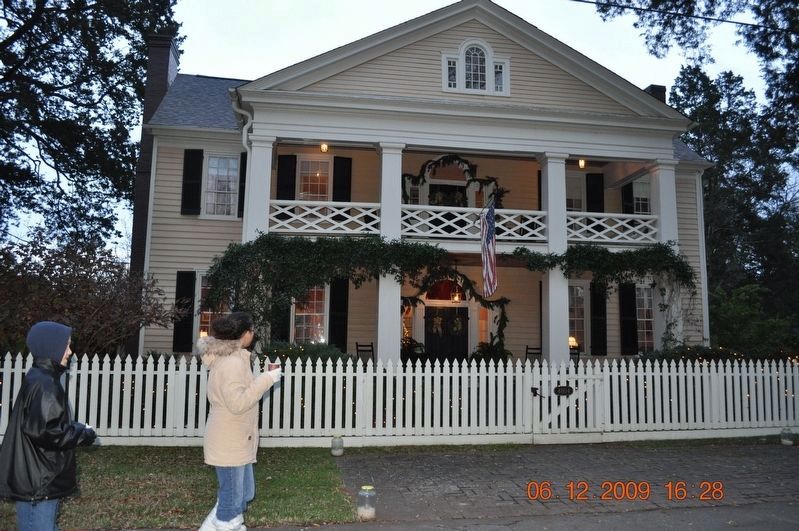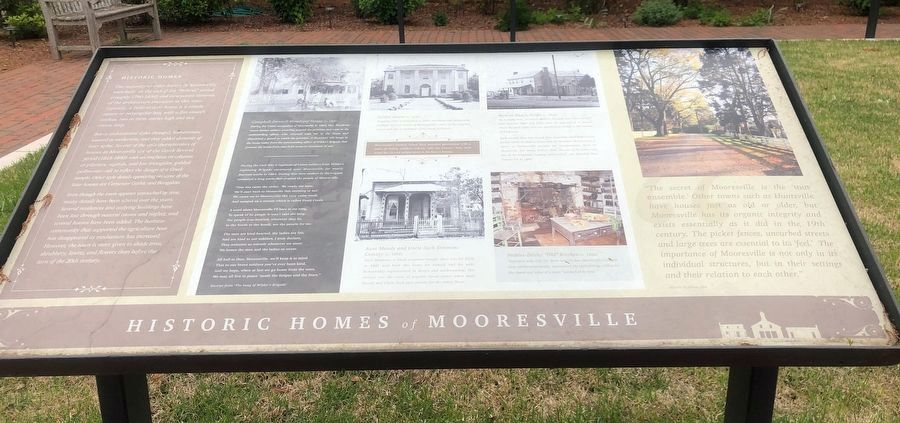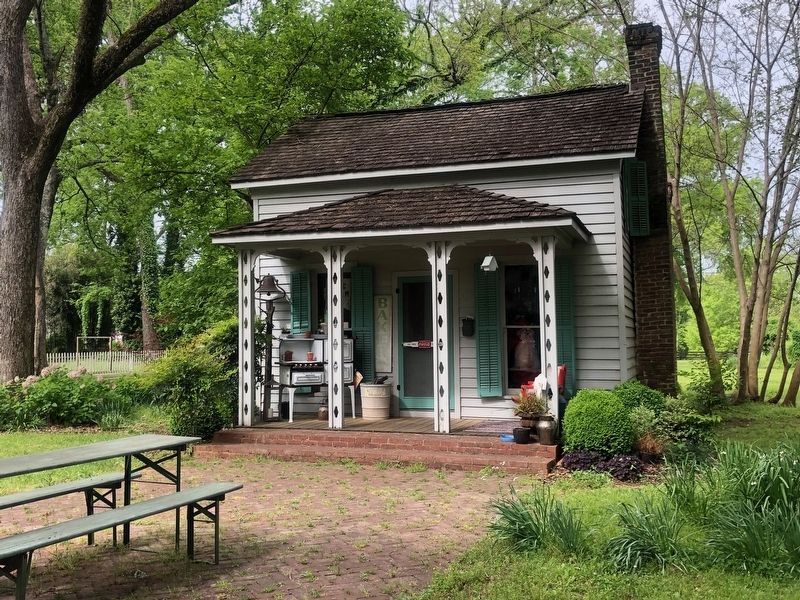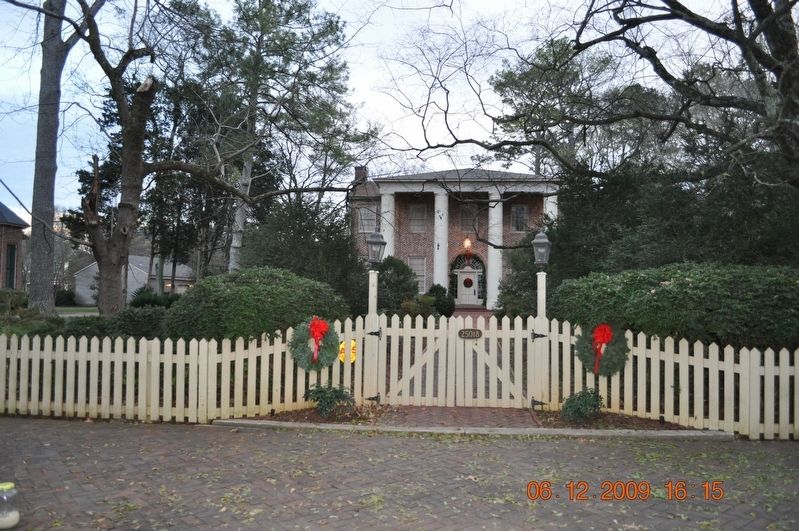Mooresville in Limestone County, Alabama — The American South (East South Central)
Historic Homes of Mooresville
The majority of older homes in Mooresville were built a the end of the "Federal" period (roughly 1790-1830) and incorporated elements of the architecture prevalent at this time. Typically, a Federal-style house is a simple square or rectangular box, with a flat smooth surface, two or three stories high and two rooms deep.
But as architectural styles changed, homeowners wanted to modernize, and they added elements of late styles. Several of the style characteristics of houses in Mooresville are the Greek Revival period (1815-1840) with an emphasis on columns or pilasters, capitals, and low triangular, gabled pediments-all to reflect the design of a Greek temple. Other style details appearing on some of the later houses are Carpenter Gothic and Bungalow.
Even though the town appears untouched by time, many details have been altered over the years. Several residences and outlying buildings have been lost through natural causes and neglect, and several houses have been added. The business community that supported the agriculture base has disappeared as the mechanism has increased. However, the town is more given to shade trees, shrubbery, lawns, and flower than before the turn of the 20th century.
Campbell-Donnell-Woodroof House (c. 1829)
During the Union occupation of Mooresville in 1863, Mrs. Woodroof heard Yankee soldiers prowling around the premises and went to the commanding officer, who returned with her to the house and dispatched a guard to watch the premises. A document still hangs in the house today from the commanding officer of Wilder's Brigade that protects the house from search for arms or munitions of war.
During the Civil War, a regiment of Union soldiers from Wilder's Lighting Brigade encamped near Mooresville for nearly fourteen weeks in 1864. During that time soldiers in the brigade composed a long poem that praised the people of Mooresville.
"One day came the order, "Be ready, my men; We'll start back to Huntsville this morning at ten; We came on to Mooresville the very same week, And camped on a stream which is called Piney Creek.Excerpt from the 'The Song of Wilder's Brigade'
A word about Mooresville I'll have in my song, To speak of its people it won't take me long; For people true-hearted, wherever they be, In the North or the South, are the people for me.
The men are kind-hearted, the ladies are fair, and are kind to our soldiers, I truly declare, They welcome us warmly whenever we meet; We honor the men and the ladies so sweet.
All hail to thee, Mooresville, we'll keep it in mind That to our brave soldiers you've ever been kind, And we hope when at last we go home fromthe wars, We may all live in peace 'neath the Stripes and the Stars."Photographed By Sandra Hughes Tidwell, April 17, 20212. Aunt Mandy and Uncle Zach Simmons Cottage (c.189Zach Simmons, a black carpenter bought these lots for $225 in 1891 and built this home for himself and his wife. Remarkably sophisticated in design and workmanship, this cottage was the scene of popular social events when Aunt Mandy and Uncle Zack gave parties for the entire town.
"The secret of Mooresville is the 'tout ensemble.' Other towns such as Huntsville have houses just as old or older, but Mooresville has it organic integrity and exists essentially as it did in the 19th century. The picket fences, uncurbed streets and large trees are essential to its 'feel.' The importance of Mooresville is not only its individual structures, but in their settings and their relation to each other."
Topics. This historical marker is listed in these topic lists: Architecture • Colonial Era • Settlements & Settlers. A significant historical year for this entry is 1864.
Location. 34° 37.594′ N, 86° 52.775′ W. Marker is in Mooresville, Alabama, in Limestone County. Marker can be reached from Lauderdale Street west of East Street (County Road 71), on the right when traveling west. Located in the Garden next to the Brick Church. Touch for map. Marker is in this post office area: Mooresville AL 35649, United States of America. Touch for directions.
Other nearby markers. At least 8 other markers are within 2 miles of this marker, measured as the crow flies. Mooresville Brick Church/The Cumberland Presbyterian Church (a few steps from this marker); Mooresville Alabama (a few steps from this marker); Historic Buildings in Mooresville (within shouting distance
of this marker); Historic Mooresville (within shouting distance of this marker); Mooresville, Alabama / Mooresville Stagecoach Inn and Tavern (about 300 feet away, measured in a direct line); Cottonport / Mooresville (about 400 feet away); a different marker also named Mooresville (about 400 feet away); Belle Mina / Woodside (approx. 1.2 miles away). Touch for a list and map of all markers in Mooresville.

Photographed By Sandra Hughes Tidwell, December 6, 2009
4. Campbell-Donnell-Woodroof House (c.1829)
During the Union occupation of Mooresville in 1863, Mrs. Woodroof heard Yankee soldiers prowling around the premises and went to the commanding officer, who returned with her to the house and dispatched a guard to watch the premises. A document still hangs in the house today from the commanding officer of Wilder's brigade that protects the house from the search for arms or munitions of war.
Credits. This page was last revised on January 6, 2022. It was originally submitted on January 5, 2022, by Sandra Hughes Tidwell of Killen, Alabama, USA. This page has been viewed 473 times since then and 75 times this year. Photos: 1, 2, 3, 4. submitted on January 5, 2022, by Sandra Hughes Tidwell of Killen, Alabama, USA. • Mark Hilton was the editor who published this page.


